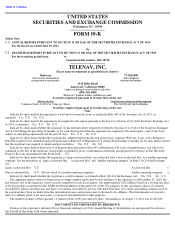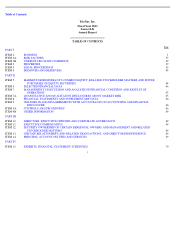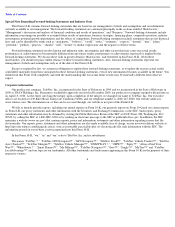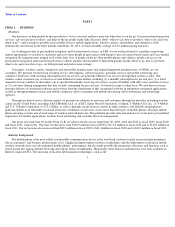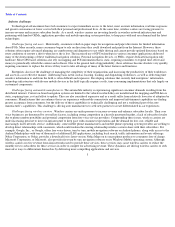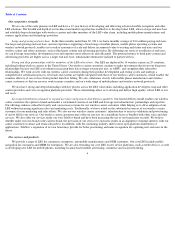TeleNav 2011 Annual Report Download - page 5
Download and view the complete annual report
Please find page 5 of the 2011 TeleNav annual report below. You can navigate through the pages in the report by either clicking on the pages listed below, or by using the keyword search tool below to find specific information within the annual report.
Table of Contents
PART I
Overview
Our mission is to help people be more productive, be less stressed, and have more fun when they’
re on the go. Our personalized navigation
services “get you and get you there” and help on-the-go people make daily decisions about “where to go, how to get there, what to do, and even
when to go”—and we make it possible across mobile devices, mobile applications, wireless carriers, automobiles, and enterprises, both
domestically and abroad. In the three months ended June 30, 2011, we had a monthly average of 24.6 million paying end users.
As a leading provider of personalized navigation and location based services, or LBS, we are well-positioned to capitalize on growing
market opportunities to reach new customers and serve more people in more places with features such as location based search and voice-guided
navigation. By using the most integral tools of the daily lives of people on the go, their mobile phones and vehicles, people can access our
personalized navigation and location based services almost anytime and anywhere to help them quickly decide where to go, how to get there,
what to do, and even when to go—in both personal and professional settings.
Consumers, wireless carriers, enterprises and automobile manufacturers and original equipment manufacturers, or OEMs, are our
customers. We generate revenue from recurring service subscriptions, software licenses, premium services and mobile advertising and
commerce. End users with recurring subscriptions for our services are generally billed for our services through their wireless carrier. Our
wireless carrier customers pay us based on several different revenue models, including (1) a monthly subscription fee per end user, (2) a fixed
annual fee for any number of subscribers (up to specified thresholds) receiving our services as part of bundles with other voice and data services,
or (3) a revenue sharing arrangement that may include a minimum fee per end user, (4) based on usage or other basis. We also derive revenue
from the delivery of customized software and royalties from the distribution of this customized software in automotive navigation applications,
as well as through premium services and mobile commerce sold to consumers and mobile advertising sold to advertisers and advertising
agencies.
Through our hosted service delivery model, we provide our solutions to end users and customers through the networks of leading wireless
carriers in the United States, including AT&T Mobility LLC, or AT&T, Sprint Nextel Corporation, or Sprint, T-Mobile USA, Inc., or T-Mobile,
and U.S. Cellular Corporation, or U.S. Cellular, as well as through certain wireless carriers in other countries. Our flexible and proprietary
platform enables us to efficiently reach and retain tens of millions of end users, across more than 600 types of mobile phones, all major mobile
phone operating systems and a broad range of wireless network protocols. This platform provides data and analytics to create more personalized
experiences for mobile applications, location based advertising and customer lifecycle management.
Our fiscal year ends June 30. In this Form 10-K, we refer to the fiscal year ended June 30, 2009, 2010 and 2011 as fiscal 2009, fiscal 2010
and fiscal 2011, respectively. Our total revenue grew from $110.9 million in fiscal 2009 to $171.2 million in fiscal 2010 and to $210.5 million in
fiscal 2011. Our net income also increased from $29.6 million in fiscal 2009 to $41.4 million in fiscal 2010 and to $42.6 million in fiscal 2011.
Industry background
The mobile phone is the most widely used portable communication device in the world and continues to play an increasingly prominent
role in consumers’ and business professionals’ lives. Significant improvements in device technologies and the deployment of advanced mobile
wireless networks have not only enhanced mobile phones’ performance, but also made possible the integration of features and functions such as
email, instant messaging, Internet browsing and various forms of multimedia. Historically, these features and functions were only available on
Internet connected PCs. The inclusion of location determination technologies, such as the
1
ITEM 1.
BUSINESS


